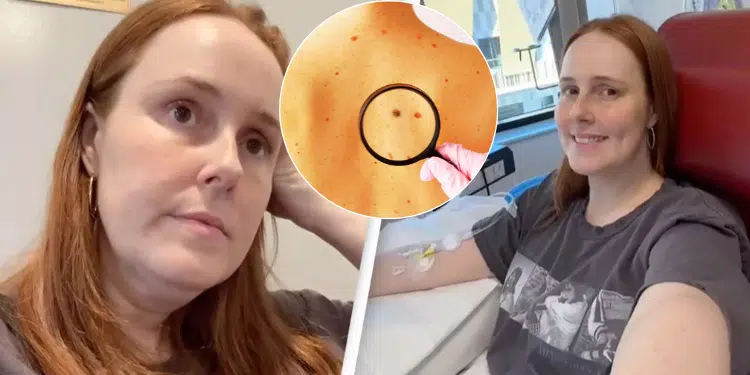Skin cancer is the most common type of cancer worldwide, and early detection is crucial for effective treatment.
Unfortunately, for Courtney Mangan, a 34-year-old from Australia’s Gold Coast, a simple mole turned out to be stage 4 melanoma – one of the deadliest forms of skin cancer.
Despite seeking medical advice early on, Courtney’s diagnosis came too late to avoid the aggressive progression of her cancer.
Now, she’s using her experience to raise awareness about the symptoms of skin cancer and the importance of being proactive about your health.
Her Journey to Diagnosis
Courtney had always been diligent about monitoring her skin. She even sought medical advice when her family noticed that a mole on her back had begun to change.
“I had a mole on my back that I never really saw, but my family told me it started to change and urged me to see a doctor,” Courtney explained.
During her first visit, her doctor conducted a full-body check and assured her that everything seemed normal.
However, Courtney persisted in voicing her concern about the changing mole. Her specialist eventually agreed to take a sample and send it for pathology.
The results were devastating. Courtney received a call confirming that the mole was a level four melanoma, a form of skin cancer that had already spread.
The Challenges of Stage 4 Melanoma
Stage 4 melanoma is the most advanced stage of the disease, meaning the cancer has spread to distant lymph nodes, tissues, or organs.
At this stage, treatment options are limited, and survival rates are significantly lower.
Courtney was given just an 18% chance of survival, a figure that highlights how crucial early detection and intervention are in battling skin cancer.
The Symptoms She Missed
Courtney now reflects on the signs she wishes she had noticed earlier.
- Changing Mole: The mole on her back had started to change shape and color, a key warning sign of melanoma.
- Family Observations: She admits she hadn’t been able to monitor the mole herself, as it was on her back. Family members brought the changes to her attention.
These subtle changes could easily go unnoticed, especially for moles in hard-to-see areas like the back.
Courtney’s Warning to Others
Courtney is now urging others to prioritize skin checks and listen to their bodies.
“I wish I had been more proactive. If something feels off, push for answers. Even if it seems small, it could save your life,” she told Daily Mail Australia.
Her message is clear: trust your instincts and advocate for your health, even if initial medical opinions seem reassuring.
How to Detect Skin Cancer Early
Skin cancer can be caught early if you know what to look for. Courtney’s story highlights the importance of regular self-checks and being aware of subtle changes in your skin.
The ABCDE Rule for Spotting Melanoma
- A – Asymmetry: One half of the mole doesn’t match the other.
- B – Border: Irregular, notched, or blurred edges.
- C – Color: Uneven shades of brown, black, red, or white.
- D – Diameter: Larger than 6mm (the size of a pencil eraser).
- E – Evolving: Changes in size, shape, color, or texture.
Other Symptoms to Watch For
- New growths or sores that don’t heal.
- Itching, bleeding, or tenderness in a mole or lesion.
- Dark streaks under nails or in hard-to-see areas.
Tips for Prevention
- Perform Regular Skin Checks: Examine your skin monthly, using a mirror to check hard-to-see areas.
- Protect Your Skin from UV Rays: Use sunscreen with at least SPF 30, wear protective clothing, and avoid tanning beds.
- Visit a Dermatologist Annually: Professional skin checks can catch changes you might miss.
- Listen to Your Body: If you notice changes in your skin or feel uneasy about something, seek medical advice immediately.
Courtney’s Hope for the Future
Despite her grim prognosis, Courtney remains hopeful and determined to spread awareness about the importance of early detection.
She’s committed to using her story to encourage others to take action.
Her advice is simple yet powerful:
“Don’t ignore the little things. They could be the difference between life and death.”|
Fortunately, Courtney has been cancer-free for three years, a milestone she cherishes deeply.
However, she admits that the fear of recurrence is always present, describing it as “a dark cloud hanging over you all the time.”
Courtney’s story is a stark reminder of how quickly skin cancer can progress and how important it is to act early.
By knowing the signs and taking preventative measures, you can protect yourself and your loved ones from this potentially deadly disease.
If her story resonates with you, share it with your family and friends. Together, we can raise awareness and save lives.

